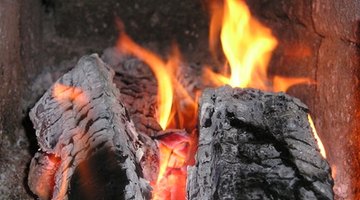How to Calculate Cords of Wood to Heat 1,200 Square Feet
Burning wood is an effective way to save money on your heating bills. It is important, though, to buy the proper amount of wood. If you don't buy enough, you can run out in the middle of the winter, when firewood is unavailable or more expensive. If you buy too much, your wood might rot or become excessively dry as it sits around until the following winter. A few calculations will allow you to make a fairly accurate prediction of your annual firewood needs.
Calculate Your Heating Needs

Step 1
Determine your house's heat loss per hour per degree of temperature difference. This calculation is somewhat complicated because it involves the size, configuration, insulation, and infiltration characteristics of your house. For a 1,200-square-foot house, a reasonable estimate is 800 Btus lost per hour per degree of temperature difference.
Step 2
Look up the annual "heating degree days" for your region. This information is available from the website of the National Climatic Data Center. Most areas of the United States are in the range of 1,000 to 9,000 heating degree days. The following example uses the average value of 5,000.
Step 3
Multiply your heat loss per hour by 24 to get heat loss per day: 800 x 24 = 19,200 Btus lost per day.
Step 4
Multiply your heat loss per day by your annual heating degree days: 19,200 x 5,000 = 96 million Btus lost per heating season. This is the amount of heat your wood supply must generate to maintain your house at 65 degrees Fahrenheit throughout the heating season.
Calculate Wood Supply
Step 1
Determine the energy content of the species of wood you will be burning. Different types of wood provide different amounts of heat energy per cord. An average value is 20 million Btus per cord.
Step 2
Multiply this previous number by the efficiency of your wood stove or fireplace. If you can't figure out the efficiency, you can use the typical value of 50 percent: 20 million x 0.50 = 10 million Btus of heat available from each cord of wood.
Step 3
Divide your total heat requirement by the heat output per cord: 96 million/10 million = 9.6 cords of wood. So in this example, a 1,200-square-foot house in an area with 5,000 heating degree days would require about 10 cords of wood per heating season.
Resources
Writer Bio
Joseph West has been writing about engineering, agriculture and religion since 2006. He is actively involved in the science and practice of sustainable agriculture and now writes primarily on these topics. He completed his copy-editing certificate in 2009 and holds a Bachelor of Science degree from the University of California-San Diego.
Photo Credits
- fire image by ivan kmit from Fotolia.com
More Articles



